Banco Bradesco Bundle
Can Banco Bradesco Maintain Its Dominance in Brazil's Banking Arena?
The Brazilian financial services industry is a battleground of titans, and Banco Bradesco SWOT Analysis is a key player. Established in 1943, Bradesco has evolved from a regional bank to a national powerhouse, constantly adapting to technological shifts and consumer demands. Understanding its position within the competitive landscape is crucial for anyone seeking to navigate the complexities of the Brazilian market.
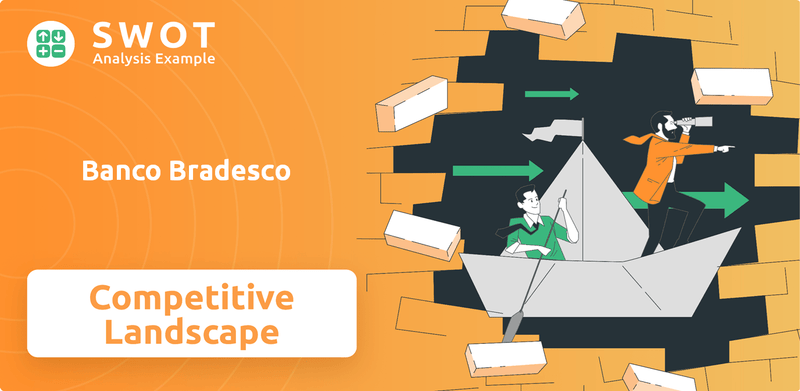
This analysis dives deep into the competitive landscape of Banco Bradesco, examining its key rivals and market position within the Brazilian banking sector. We'll explore the competitive advantages that have fueled Bradesco's success, along with the challenges and opportunities it faces in a rapidly changing financial services industry. Our market analysis will provide actionable insights for investors, analysts, and strategists alike, offering a comprehensive understanding of Bradesco's performance compared to its competitors.
Where Does Banco Bradesco’ Stand in the Current Market?
Banco Bradesco holds a significant position within the Brazilian financial services industry. It consistently ranks among the top private banks in Brazil, often competing with Itaú Unibanco and Santander Brasil for the leading spot. This strong market presence is a key factor in its competitive landscape. Understanding the competitive landscape of Banco Bradesco requires a close look at its core operations and value proposition.
Bradesco's core operations span retail banking, corporate banking, investment banking, asset management, and insurance. The bank serves a diverse customer base, from individuals and SMEs to large corporations. Its value proposition lies in its extensive physical and digital infrastructure, providing comprehensive financial solutions to a broad spectrum of clients. The company's diverse product lines and wide customer reach are critical elements in its competitive strategy. For further insights, you can explore the Owners & Shareholders of Banco Bradesco.
Bradesco's financial health remains robust, with a reported net income of R$16.3 billion in 2023. This financial performance reflects its operational efficiency and strong market presence within the banking sector. The bank's ability to maintain profitability is a key indicator of its competitive strength and resilience against market changes.
Bradesco consistently ranks among the top three private banks in Brazil. While specific 2025 market share figures fluctuate, it frequently competes with Itaú Unibanco for the top position. This strong market share is a crucial factor in the competitive landscape.
As of December 2023, Bradesco reported R$1.96 trillion in total assets. The company's net income in 2023 was R$16.3 billion, reflecting its operational efficiency. These financial figures underscore its position as a financial giant.
Bradesco offers a wide range of services, including retail banking, corporate banking, investment banking, asset management, and insurance through Bradesco Seguros. This diversified portfolio helps the bank cater to various customer needs. The breadth of its offerings is a key competitive advantage.
Its geographic presence is primarily concentrated in Brazil, where it has an extensive branch and ATM network. Bradesco also has international operations, though its main focus remains the Brazilian market. This strong domestic presence supports its competitive edge.
Bradesco's market position is characterized by its strong ranking, substantial assets, and diverse product offerings. It has a significant presence in the Brazilian banking market. The bank's strategic focus on digital transformation and diversification further strengthens its competitive standing.
- Top-tier private bank in Brazil.
- R$1.96 trillion in total assets as of December 2023.
- Diverse product lines including retail, corporate, and investment banking.
- Extensive branch and ATM network in Brazil.
Banco Bradesco SWOT Analysis
- Complete SWOT Breakdown
- Fully Customizable
- Editable in Excel & Word
- Professional Formatting
- Investor-Ready Format
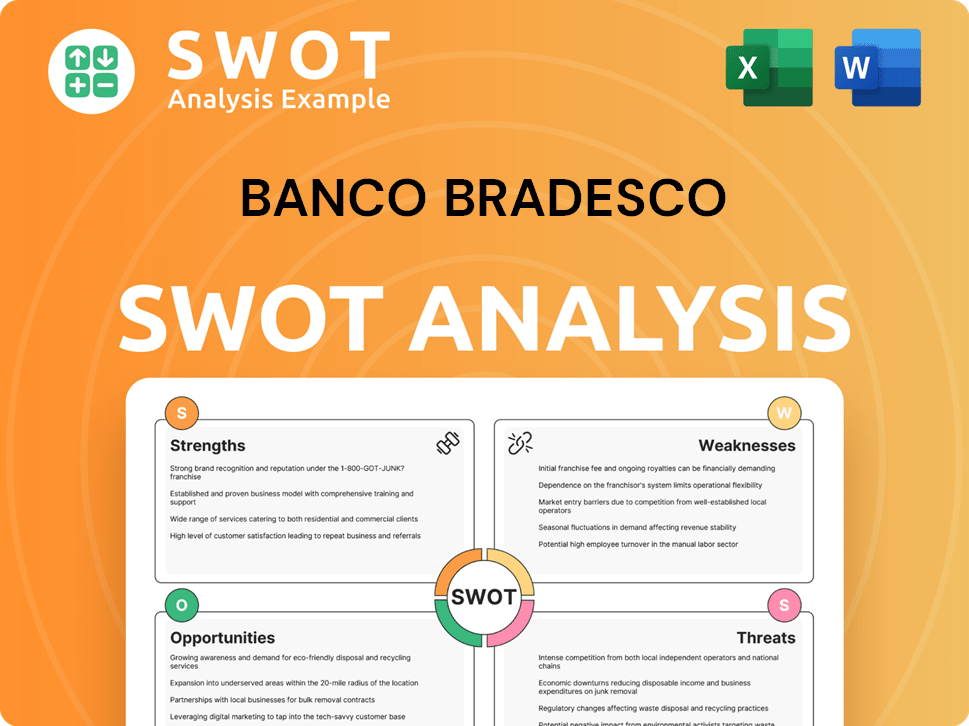
Who Are the Main Competitors Challenging Banco Bradesco?
The competitive landscape of Banco Bradesco in the Brazilian financial services industry is intense, shaped by major players and emerging digital disruptors. The market analysis reveals a dynamic environment where traditional banking models face challenges from innovative fintech solutions. Understanding the Bradesco competitors and their strategies is crucial for assessing the bank's position and future prospects. The banking sector in Brazil is undergoing significant transformation, driven by technological advancements and evolving customer preferences.
The Brazilian banking sector is experiencing a rapid evolution, with traditional institutions like Banco Bradesco adapting to the rise of digital banking and fintech companies. The competitive pressures are intensifying, requiring constant innovation and strategic adjustments. A deep dive into the competitive landscape provides insights into the challenges and opportunities facing Banco Bradesco. The financial services industry in Brazil is witnessing shifts in customer behavior, technological advancements, and regulatory changes, which influence the competitive dynamics.
The competitive landscape for Banco Bradesco is primarily defined by its direct competitors, state-owned banks, and the growing influence of fintech companies. The bank's ability to maintain and grow its market share depends on its strategic responses to these diverse competitive pressures. For more background, you can review the Brief History of Banco Bradesco.
Itaú Unibanco is a major competitor, often considered the largest private bank in Brazil by market value. Santander Brasil, the local subsidiary of the Spanish banking giant, is another key rival. These banks compete with Bradesco across various financial products and services.
Banco do Brasil and Caixa Econômica Federal are significant competitors, particularly due to their extensive reach and focus on specific segments. Banco do Brasil has a strong presence in agribusiness and public sector financing. Caixa Econômica Federal leads in housing finance and social programs.
Fintechs and digital banks, such as Nubank, are rapidly gaining market share. These companies offer digital-first services, lower fees, and user-friendly interfaces, challenging traditional branch-based models. The rise of digital disruptors forces Bradesco to accelerate its digital transformation.
Major retailers and telecommunication companies entering financial services add indirect competition. These companies offer payment solutions and digital wallets, challenging Bradesco's dominance in payment processing and consumer finance. This diversification of financial services providers increases the overall competitive pressure.
The Brazilian banking market is characterized by a concentration of market share among a few major players. However, fintechs and digital banks are steadily increasing their presence, especially among younger demographics. This shift in market share dynamics requires traditional banks to adapt quickly.
Banco Bradesco responds to the competitive landscape through digital transformation initiatives, strategic partnerships, and product innovation. The bank invests in technology to enhance its digital offerings, improve customer experience, and streamline operations. Partnerships with fintech companies and other businesses expand its reach and service offerings.
Several factors drive competition in the Brazilian banking market, including pricing strategies, digital innovation, customer service, and brand reputation. Banks compete on interest rates, fees, and the availability of financial products. Digital innovation, such as mobile banking apps and online platforms, is critical. Superior customer service and a strong brand reputation enhance customer loyalty and attract new clients.
- Pricing Strategies: Competitive interest rates and fees are essential for attracting and retaining customers.
- Digital Innovation: Investment in digital platforms and mobile banking apps is crucial for staying competitive.
- Customer Service: Excellent customer service enhances customer loyalty and satisfaction.
- Brand Reputation: A strong brand reputation builds trust and attracts new customers.
Banco Bradesco PESTLE Analysis
- Covers All 6 PESTLE Categories
- No Research Needed – Save Hours of Work
- Built by Experts, Trusted by Consultants
- Instant Download, Ready to Use
- 100% Editable, Fully Customizable
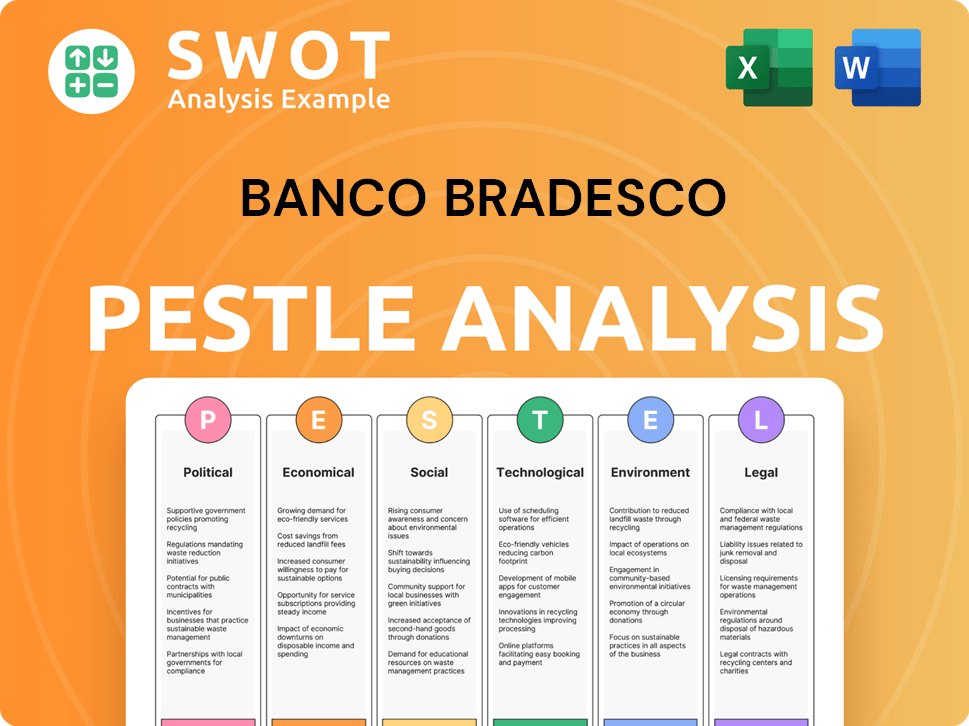
What Gives Banco Bradesco a Competitive Edge Over Its Rivals?
Understanding the competitive landscape of Banco Bradesco involves assessing its strengths and how it stacks up against its rivals in the financial services industry. Key to this analysis are the competitive advantages that have allowed Bradesco to maintain a strong position in the Brazilian banking sector. The following details provide a comprehensive look at these strengths, and how they contribute to Bradesco's success.
As a leading player in the Brazilian financial market, Bradesco faces competition from both traditional banks and emerging fintech companies. A thorough market analysis reveals that Bradesco's strategy focuses on leveraging its established infrastructure and brand recognition while embracing digital transformation. This approach is crucial for maintaining its competitive edge in a rapidly evolving landscape. This article offers insights into the competitive advantages of Banco Bradesco, its strategic positioning, and its response to market dynamics.
Bradesco's ability to adapt and innovate is key to its sustained success. The company has been consistently investing in technology and customer service to meet the changing demands of the market. Analyzing its competitive advantages provides a clear picture of how Bradesco aims to stay ahead of its competitors, including both established banks and new digital entrants. For more information about the target audience, check out the Target Market of Banco Bradesco.
Bradesco's expansive network of branches and ATMs across Brazil is a significant advantage, especially in regions where digital banking is less prevalent. This physical presence fosters customer trust and provides accessibility. With thousands of locations, Bradesco offers a tangible point of contact for customers, setting it apart from digital-only competitors.
Bradesco has built a strong reputation for reliability and comprehensive financial services, leading to high customer loyalty. This brand recognition aids in retaining existing clients and attracting new ones. Consistent marketing and customer service reinforce this positive image, making Bradesco a trusted name in the Brazilian banking sector.
The company's diverse portfolio, including retail, corporate, investment banking, asset management, and insurance (Bradesco Seguros), generates multiple revenue streams. This diversification allows for cross-selling opportunities, increasing customer lifetime value. A wide range of products and services enables Bradesco to meet various financial needs.
Bradesco's large asset base and extensive operations allow for significant economies of scale, optimizing costs and enabling heavy investments in technology. This scale supports competitive pricing and substantial investments in digital transformation. Bradesco has invested in AI, big data analytics, and digital platforms to enhance customer experience and streamline operations.
Bradesco's competitive advantages include its extensive physical distribution network, strong brand equity, diversified product portfolio, and economies of scale. These factors contribute to its robust market position and ability to withstand competition. The company’s strategic investments in technology and customer service further enhance its competitive edge.
- Extensive Branch Network: Thousands of branches and ATMs across Brazil provide widespread accessibility.
- Strong Brand Reputation: Reliability and comprehensive services build customer loyalty.
- Diversified Financial Services: Multiple revenue streams and cross-selling opportunities.
- Technological Investments: Focus on AI, big data, and digital platforms for enhanced customer experience.
Banco Bradesco Business Model Canvas
- Complete 9-Block Business Model Canvas
- Effortlessly Communicate Your Business Strategy
- Investor-Ready BMC Format
- 100% Editable and Customizable
- Clear and Structured Layout
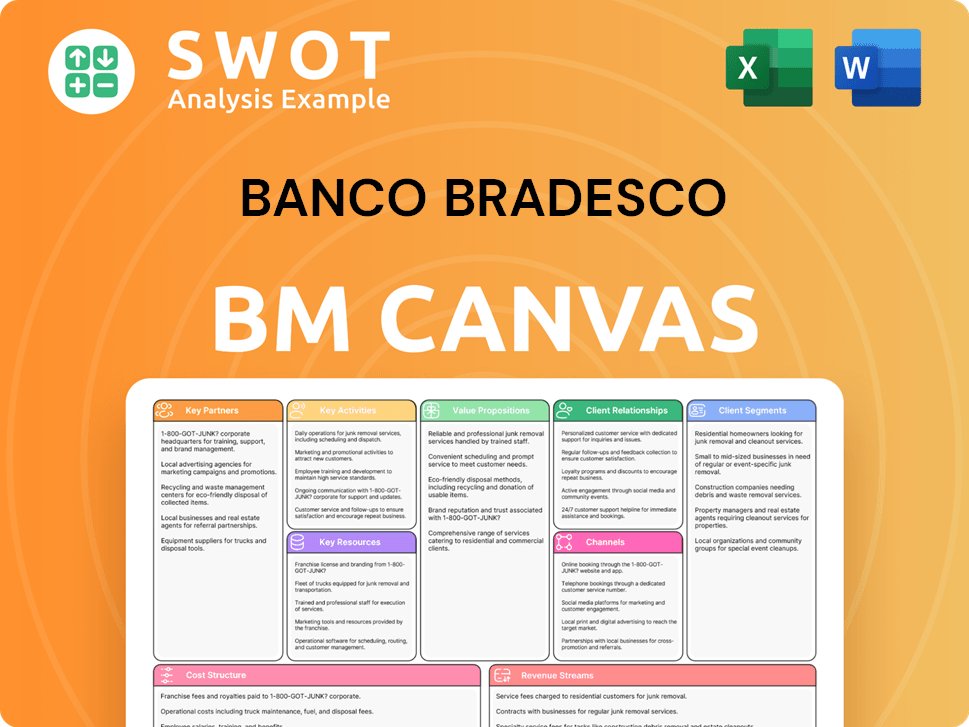
What Industry Trends Are Reshaping Banco Bradesco’s Competitive Landscape?
The Banco Bradesco operates within a dynamic financial services industry in Brazil, facing both established rivals and emerging fintech companies. A thorough market analysis reveals that the competitive landscape is shaped by technological advancements, regulatory changes, and evolving customer preferences. Understanding Bradesco's competitors and their strategies is crucial for assessing its future performance.
The banking sector in Brazil is undergoing significant transformation, with digital innovation at the forefront. This creates both risks and opportunities for Banco Bradesco, requiring strategic adaptation to maintain its market position. The future outlook for Banco Bradesco's competitive landscape hinges on its ability to navigate these changes effectively.
The Brazilian financial sector is experiencing rapid digitalization, with a strong emphasis on mobile banking and digital payments. Open banking initiatives are fostering greater competition and innovation. Regulatory changes, such as data privacy laws, are also influencing the market.
Banco Bradesco faces challenges from agile fintechs and digital banks with lower overheads. Economic volatility, including inflation and interest rate fluctuations, poses risks. Continuous innovation and attracting tech talent are essential for maintaining a digital edge.
Open banking provides opportunities for Banco Bradesco to develop tailored products and expand its reach. The growing financial inclusion in Brazil allows for onboarding new customer segments. Leveraging its brand and diversified offerings can boost cross-selling.
Bradesco is focusing on digital transformation, innovation, and leveraging its customer base. This includes expanding digital services and exploring partnerships. For a deeper understanding, explore the Revenue Streams & Business Model of Banco Bradesco.
Banco Bradesco needs to address the increasing competition from fintechs and digital banks. It must also manage the transition of its traditional customer base to digital channels. Furthermore, the bank should focus on adapting to regulatory changes.
- Digital Transformation: Investing in digital platforms and cybersecurity.
- Customer Experience: Enhancing mobile transactions and personalized financial advice.
- Strategic Partnerships: Collaborating with fintechs to expand market reach.
- Risk Management: Addressing economic volatility and interest rate fluctuations.
Banco Bradesco Porter's Five Forces Analysis
- Covers All 5 Competitive Forces in Detail
- Structured for Consultants, Students, and Founders
- 100% Editable in Microsoft Word & Excel
- Instant Digital Download – Use Immediately
- Compatible with Mac & PC – Fully Unlocked
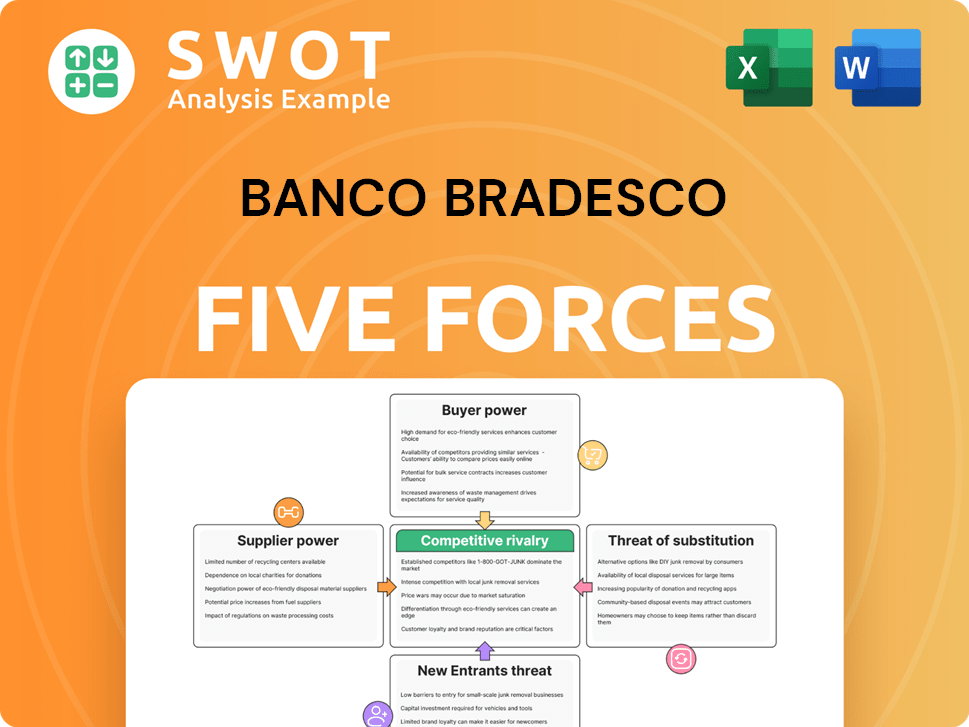
Related Blogs
- What are Mission Vision & Core Values of Banco Bradesco Company?
- What is Growth Strategy and Future Prospects of Banco Bradesco Company?
- How Does Banco Bradesco Company Work?
- What is Sales and Marketing Strategy of Banco Bradesco Company?
- What is Brief History of Banco Bradesco Company?
- Who Owns Banco Bradesco Company?
- What is Customer Demographics and Target Market of Banco Bradesco Company?
Disclaimer
All information, articles, and product details provided on this website are for general informational and educational purposes only. We do not claim any ownership over, nor do we intend to infringe upon, any trademarks, copyrights, logos, brand names, or other intellectual property mentioned or depicted on this site. Such intellectual property remains the property of its respective owners, and any references here are made solely for identification or informational purposes, without implying any affiliation, endorsement, or partnership.
We make no representations or warranties, express or implied, regarding the accuracy, completeness, or suitability of any content or products presented. Nothing on this website should be construed as legal, tax, investment, financial, medical, or other professional advice. In addition, no part of this site—including articles or product references—constitutes a solicitation, recommendation, endorsement, advertisement, or offer to buy or sell any securities, franchises, or other financial instruments, particularly in jurisdictions where such activity would be unlawful.
All content is of a general nature and may not address the specific circumstances of any individual or entity. It is not a substitute for professional advice or services. Any actions you take based on the information provided here are strictly at your own risk. You accept full responsibility for any decisions or outcomes arising from your use of this website and agree to release us from any liability in connection with your use of, or reliance upon, the content or products found herein.